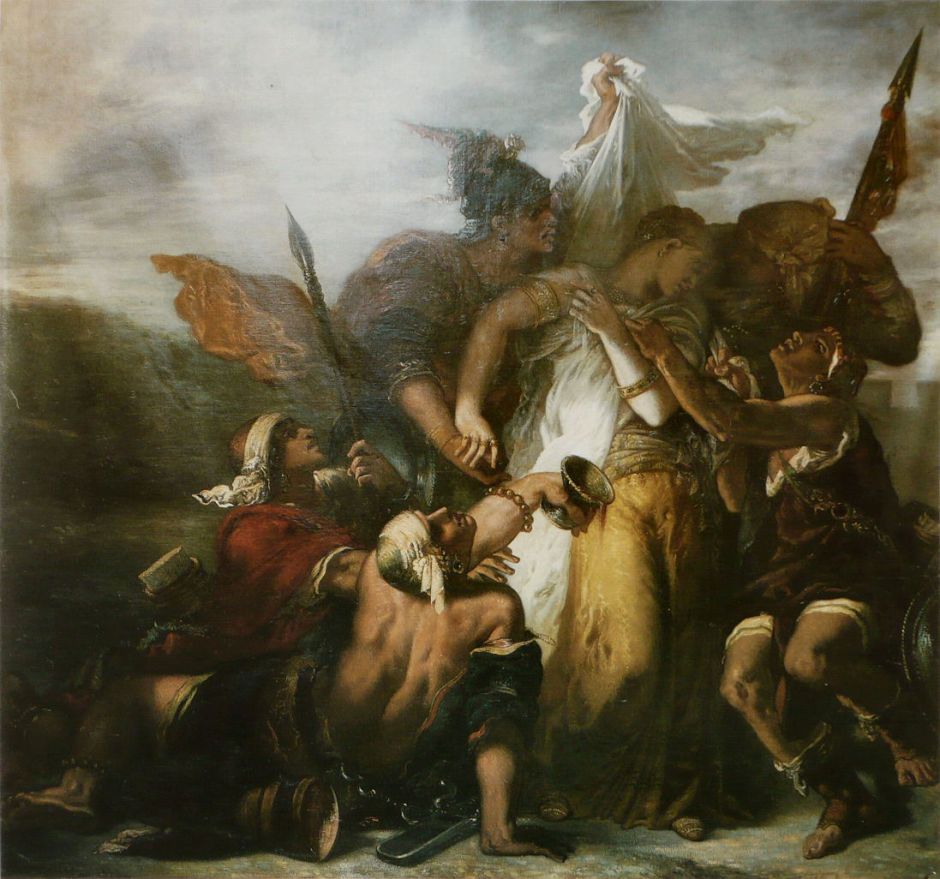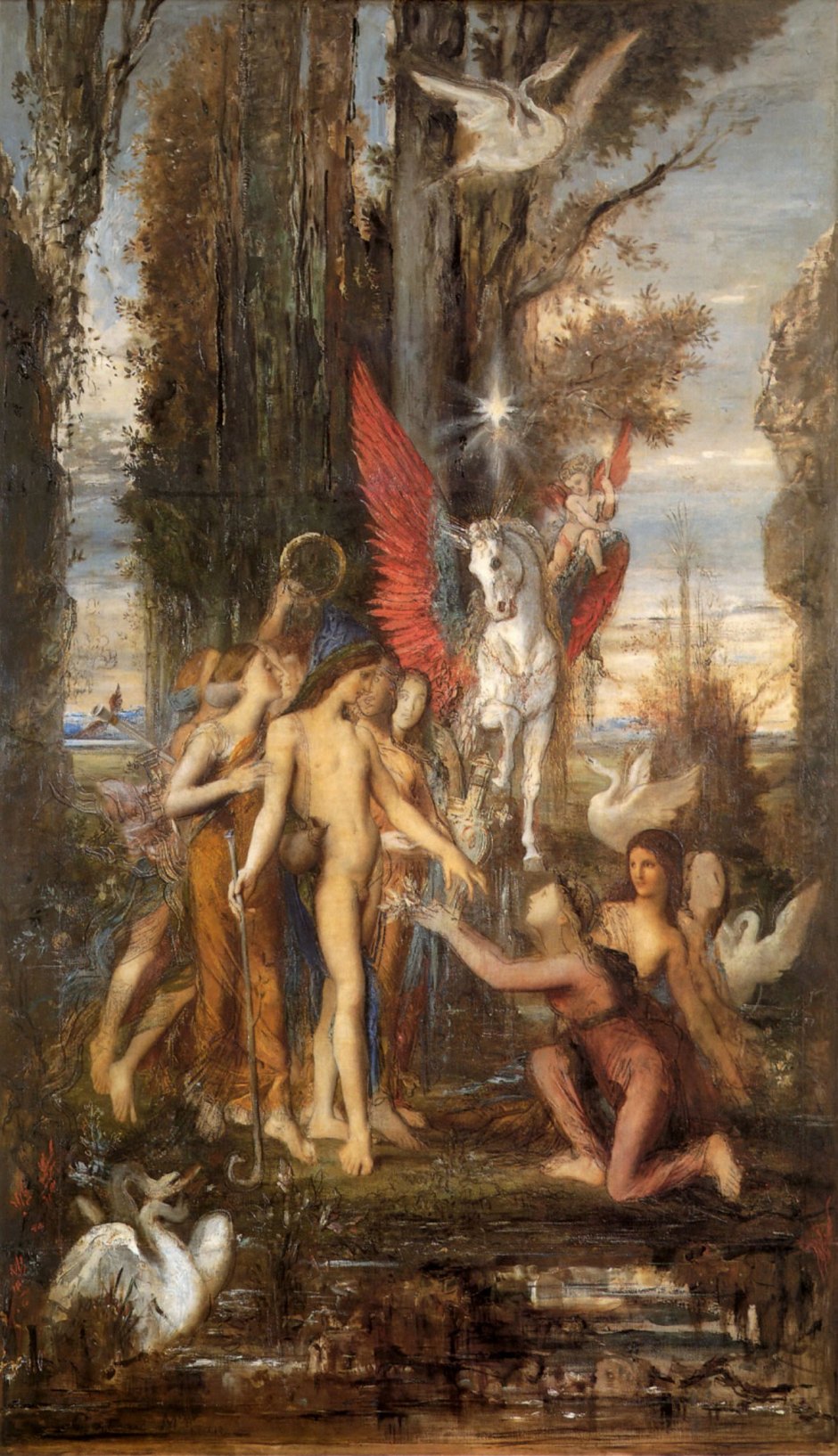Plenty of nineteenth century art was ‘difficult’, not just the works of William Blake (at the start) and Odilon Redon (at the end). This article, the first of a new series, looks at the distinctive paintings of one of the most ‘difficult’ of them all, Gustave Moreau (1826–1898).
I have previously considered Moreau’s approach to narrative, and I think may have been a little narrow-minded, even harsh, blaming him in part for the dissolution of narrative, and of history painting itself. Look elsewhere and you will see Moreau classified as a Symbolist, although trying to establish what any Symbolist movement was, is like nailing jelly to a wall.

Moreau’s paintings are at once history, symbolic explorations, as phantasmagoric as the most radical of Blake or Redon, torrents of figures and forms drawn from all human cultures, and from the deeper and more ‘primitive’. They are elaborate, complex, and appear to defy reading. This series takes up that challenge, and I hope will help you to read Moreau’s spectacular paintings, and so enjoy them more.
Moreau was a precocious artist who started copying in the Louvre, in his native Paris, when he was only seventeen. A year later he started to attend a private studio run by François-Édouard Picot, to prepare him for the entrance exam for the École des Beaux-Arts. In Picot’s studio, he learned the methods to which he adhered for the rest of his career: each painting started with a series of drawings, which developed both composition and details. The final drawing was squared up on a grid, to enable its transfer to canvas, where he painted conventionally in oils, using layers.
He was admitted to the École des Beaux-Arts in 1846, and determined that he would be a history painter. To that end, he competed twice for the Prix de Rome, which would have taken him to continue his studies in Rome, but on both occasions he was unsuccessful. He therefore left the École des Beaux-Arts in 1849, and started to make a precarious living with small commissioned works including favourite scenes from the plays of Shakespeare. His work changed markedly in 1851, the year that JMW Turner died, when he befriended Théodore Chassériau, a former pupil of Ingres; Moreau set up his first studio near that of Chassériau, and started to paint more ambitious works which he submitted to the Salon.

The Judgement of Paris (1852) is one of Moreau’s early watercolours, showing great promise of things to come. At its heart is a fairly faithful representation of this classical myth, in which Paris (right of centre) is deciding which of Hera, Athena, and Aphrodite is the most fair, and should be awarded the golden apple given by Eris from the Garden of the Hesperides.
More usually an excuse for the depiction of three beautiful nude women, Moreau prefers to provide embellishments which enrich the narrative, such as the putto about to hand the golden apple to the winner, Hermes with his caduceus, and more.

Le Cantique des cantiques (The Song of Songs) (1853) shows a scene based on a very unusual source, the Song of Songs, a long and quite intensely erotic poem in the Old Testament. Clearly it refers to chapter 5 verse 7; with the preceding and following verses, this reads:
I opened to my beloved; but my beloved had withdrawn himself, and was gone: my soul failed when he spake: I sought him, but I could not find him; I called him, but he gave me no answer.
The watchmen that went about the city found me, they smote me, they wounded me; the keepers of the walls took away my veil from me.
I charge you, O daughters of Jerusalem, if ye find my beloved, that ye tell him, that I am sick of love.
The Shulamite woman who says those verses is the woman in white at the centre of the painting, and is being attacked by the city’s watchmen, who have removed her veil. Other commentators state that this proceeds to rape, which is not even implied in the original text, nor are there any hints of that sequel in Moreau’s painting, which remains a puzzle.
In 1853, his parents bought him a house to live in, and use as a studio, in a fashionably artistic neighbourhood: he moved in, and remained there for the rest of his life; this is now the Musée Gustave Moreau, which he established later in life, and still contains the greatest collection of his paintings and drawings.
By this time, Moreau was considering his future as a painter, and exploring various possibilities, inspired mainly by Delacroix and his friend and mentor Chassériau.

He painted at least three different versions of the Pietà, this from 1854.

He also tried his hand at some vivacious equestrian works inspired by Delacroix and Alfred de Dreux, including the watercolour Two Modern Horsewomen (c 1852) above, and Scottish Horseman (c 1854) in oils, below.


Apollo and the Nine Muses (1856) shows another step towards his mature work, immersed in classical myth again. Apollo, a young and surprisingly androgynous figure, sits in the foreground, his distinctive lyre part-hidden under his right foot. To the right of him is a wild rose, with both white flowers and red hips. The muses cluster on a small mound behind that, equipped for and engaged in their respective arts. Moreau has not so much composed them into position as compressed them into a mass, in which it is difficult to distinguish even heads.
That same year, his friend and mentor Chassériau died at the age of only 37. Moreau was devastated by this, and decided to travel to Italy to complete his education as a painter and resolve his future. From October 1857 to June 1858, he copied Renaissance paintings in Rome, then moved on to Florence, Milan, and Venice. He finally returned to Paris in September 1859, having made about a thousand copies in less than two years. Moreau also met and made friends with several other artists, including Degas and Tissot.

In addition to the copies which he made in Italy, he painted some works of his own, including this landscape, which I think should be titled View of the Villa Borghese (1858), although most sources claim it is of the (unknown) Villa Borthese.

Over this period, Moreau had been working on several paintings, including one to commemorate Chassériau, and this preparatory drawing of Hesiod and the Muse (1857). It has also been claimed that he had started to paint some of his later and still unfinished works, including The Suitors, although Cooke considers that the paintings themselves were not started until after his return from Italy.
He had been thinking a lot about history painting over this period, and around the time of his return to Paris in 1859, he resolved to reform history painting with a new approach, one which dispensed with schools in its pursuit of “the art of lofty poetic and imaginative conceptions”, which was actually not about historical fact, but about myth and legend.

Hesiod and the Muses (1860) is probably the first of Moreau’s ‘new’ history paintings, and the first of a series of works in which he shows Hesiod, generally considered to be the first written poet in the Western tradition to exist as a real person, and to play an active role in his poetry. Hesiod is shown to the left of centre, as a young man holding a laurel staff in his right hand. Once again the muses are squeezed in together so that they are hard to distinguish, although I count nine of them. One is on her knee, presenting Hesiod with a laurel wreath.
There are four swans on the ground, and one in flight above Hesiod, a winged Cupid sat on the left wing of Pegasus, and a brilliant white star directly above the winged horse. However, the Cupid and Pegasus were only added in about 1883, when the canvas was extended. Cooke considers that, irrespective of the title, this addition confirms the painting’s amorous atmosphere.
In 1860, he met his mistress and muse Alexandrine Dureux (whom he never married, both remaining single) and set her up in a nearby flat, where she lived until her death in 1890.
The next article will consider the major paintings which he probably started in around 1860: The Suitors, The Daughters of Thespius, and Tyrtaeus Singing during the Combat. They were the immediate precursors to Œdipus and the Sphinx, which struck like a thunderclap in 1864.
References
Cooke P (2014) Gustave Moreau, History Painting, Spirituality and Symbolism, Yale UP. ISBN 978 0 300 20433 9.
Mathieu P-L (1998, 2010) Gustave Moreau, the Assembler of Dreams, PocheCouleur. ISBN 978 2 867 70194 8.

